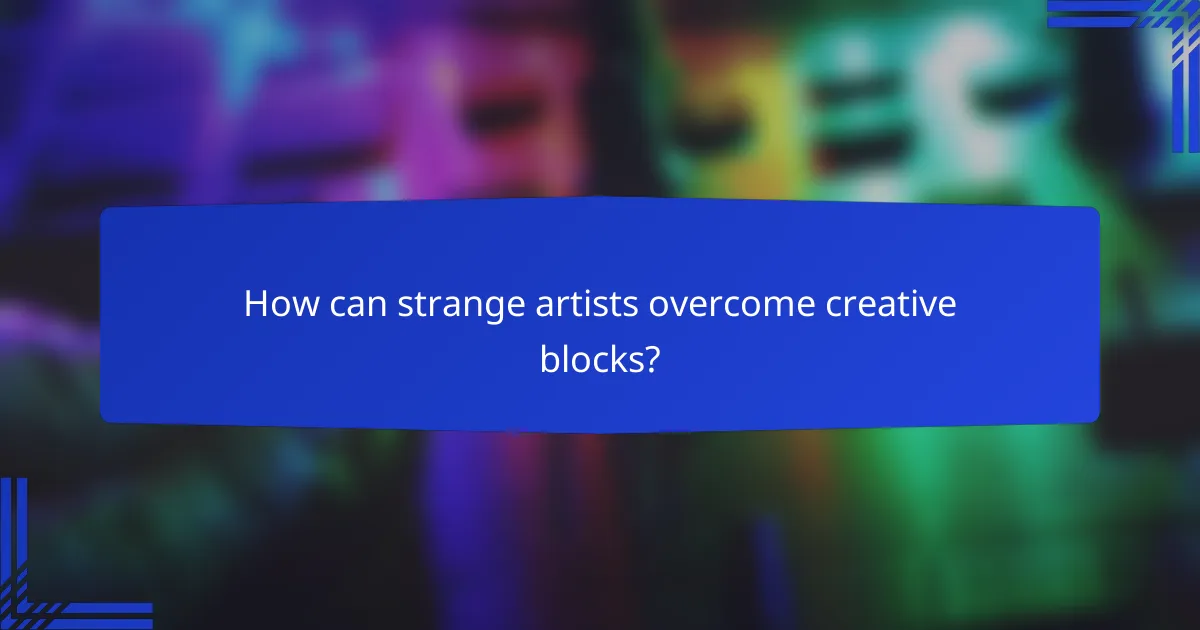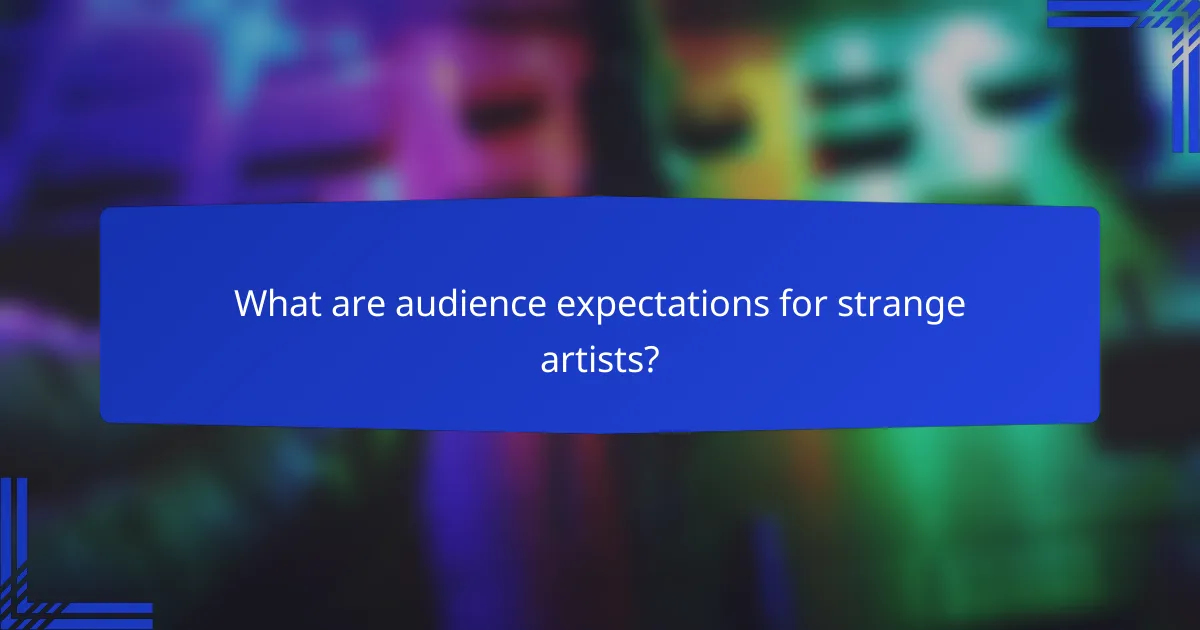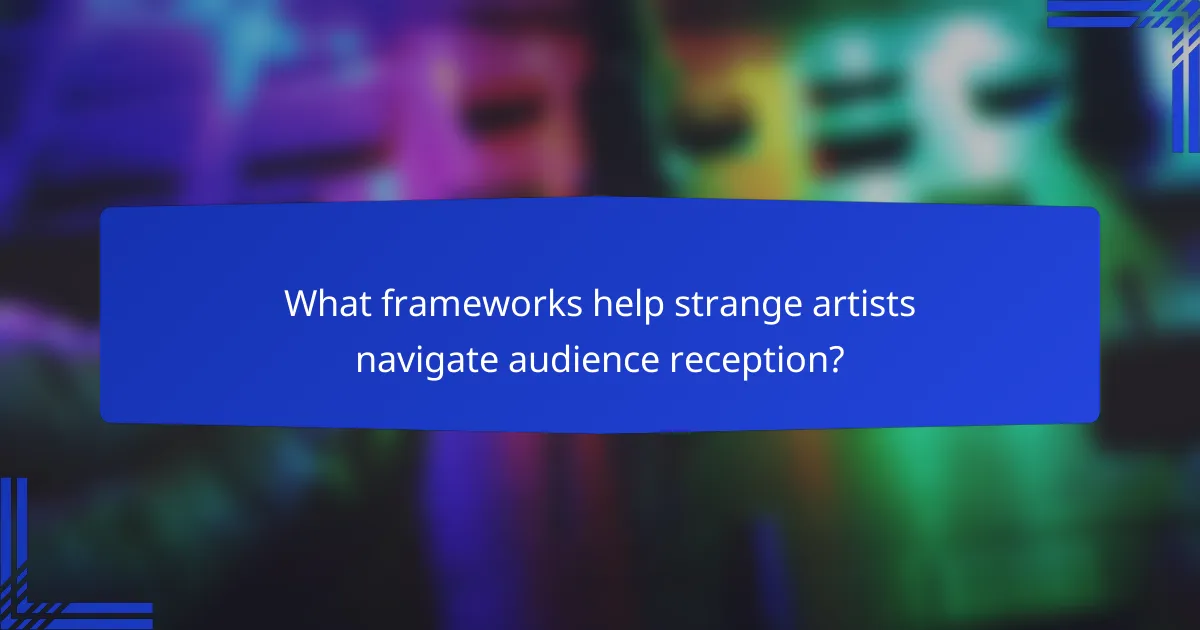Strange artists navigate the complexities of creative blocks and audience expectations through innovative strategies that foster self-expression. By embracing techniques such as mindfulness and collaboration, they can unlock new avenues for creativity while challenging conventional norms. Their work often reflects a deep authenticity, resonating with audiences who seek originality and emotional depth in artistic expressions.

How can strange artists overcome creative blocks?
Strange artists can overcome creative blocks by employing various strategies that encourage self-expression and innovation. Techniques such as mindfulness, collaboration, and exploring new mediums can help break down barriers and stimulate creativity.
Mindfulness practices
Mindfulness practices, such as meditation and deep breathing, can help artists clear their minds and focus on the present moment. By reducing anxiety and distractions, these techniques create a conducive environment for creativity to flourish.
Incorporating short mindfulness sessions into a daily routine can be beneficial. Even just five to ten minutes of focused breathing or guided meditation can help reset an artist’s mental state and inspire new ideas.
Collaborative projects
Engaging in collaborative projects allows strange artists to gain fresh perspectives and ideas from others. Working with different individuals can introduce new techniques and concepts that may not have been considered before.
When collaborating, artists should choose partners whose strengths complement their own. This synergy can lead to innovative outcomes and help break through creative barriers, making the process enjoyable and enriching.
Artistic retreats
Artistic retreats provide a focused environment where artists can immerse themselves in their craft without everyday distractions. These retreats often offer workshops, mentorship, and networking opportunities that can reignite passion and creativity.
Participating in a retreat can vary in cost, typically ranging from a few hundred to several thousand dollars, depending on the location and amenities. Artists should consider their budget and the specific offerings of each retreat to find the right fit.
Daily creative exercises
Incorporating daily creative exercises into an artist’s routine can help maintain momentum and foster new ideas. Simple activities like sketching, journaling, or experimenting with different styles can keep the creative juices flowing.
Setting aside as little as 15 to 30 minutes each day for these exercises can lead to significant improvements over time. Artists should focus on consistency rather than perfection, allowing for exploration and growth.
Exploring new mediums
Exploring new mediums can open up a world of possibilities for strange artists, helping them break free from traditional constraints. Trying out different materials, such as digital tools, sculpture, or mixed media, can spark inspiration and lead to unexpected results.
Artists should approach new mediums with an open mind and a willingness to experiment. This exploration can lead to the discovery of unique styles and techniques that enhance their overall artistic expression.

What are audience expectations for strange artists?
Audience expectations for strange artists often revolve around a desire for unique and innovative expressions that challenge conventional norms. Viewers typically seek originality, emotional resonance, and themes that diverge from mainstream narratives.
Emphasis on originality
Originality is a cornerstone of what audiences expect from strange artists. They look for fresh perspectives and innovative techniques that set the work apart from traditional art forms. This can manifest in unexpected materials, styles, or concepts that provoke thought and discussion.
To meet these expectations, artists should focus on developing their unique voice and experimenting with various mediums. Engaging in creative exercises, such as brainstorming or collaboration, can help generate original ideas that resonate with audiences.
Desire for emotional connection
Audiences often seek an emotional connection with the work of strange artists. They appreciate pieces that evoke feelings, whether it’s joy, sadness, or confusion. This emotional engagement can make the art more impactful and memorable.
Artists can foster this connection by sharing personal stories or experiences that inform their work. Transparency in the creative process and vulnerability in expression can enhance the audience’s emotional investment.
Interest in unconventional themes
Strange artists are frequently expected to explore unconventional themes that challenge societal norms or provoke critical thinking. Topics may include identity, existentialism, or the absurd, inviting viewers to reflect on deeper issues.
When addressing unconventional themes, artists should consider how to present these ideas in a relatable manner. Using symbolism or metaphor can help bridge the gap between the abstract and the accessible, allowing audiences to engage with complex concepts more easily.

How does self-expression impact strange artists?
Self-expression significantly influences strange artists by allowing them to convey their unique perspectives and emotions. This authenticity not only shapes their creative output but also affects how audiences perceive and engage with their work.
Enhances authenticity
Self-expression enhances authenticity by encouraging artists to present their true selves rather than conforming to mainstream expectations. When artists embrace their individuality, their work often resonates more deeply with audiences, creating a genuine connection.
For example, an artist who explores unconventional themes or styles may attract a niche audience that appreciates their originality. This authenticity can lead to a loyal following, as fans are drawn to the artist’s unique voice and vision.
Fosters deeper connections
Through self-expression, strange artists can foster deeper connections with their audience by sharing personal stories and experiences. When artists reveal their vulnerabilities, it invites viewers to relate to their struggles and triumphs, creating a shared emotional experience.
Art that reflects personal narratives often sparks conversations and encourages audience engagement. This interaction can be seen in various forms, such as social media discussions or community events, where fans feel more connected to the artist’s journey.
Encourages risk-taking
Self-expression encourages strange artists to take creative risks, pushing boundaries and exploring new ideas. This willingness to experiment can lead to innovative works that challenge conventional norms and provoke thought.
Artists who embrace risk-taking may find that their most unconventional pieces resonate with audiences, leading to unexpected success. However, it’s essential to balance risk with audience understanding; artists should consider how their work may be received while remaining true to their vision.

What frameworks help strange artists navigate audience reception?
Strange artists can effectively navigate audience reception by utilizing frameworks that foster understanding and connection. These frameworks include feedback loops and audience engagement strategies, which help artists align their creative expression with audience expectations while maintaining authenticity.
Feedback loops
Feedback loops are essential for strange artists to gauge audience reactions and refine their work. By actively seeking input from viewers, artists can identify what resonates and what doesn’t, allowing them to adjust their creative direction accordingly.
Establishing a consistent feedback mechanism, such as surveys or social media polls, can provide valuable insights. For example, an artist might share a draft of their work online and ask for specific feedback, which can guide their revisions and enhance audience connection.
Audience engagement strategies
Engaging the audience through various strategies can significantly improve reception of an artist’s work. Techniques such as interactive installations, live performances, or social media engagement can create a more immersive experience for viewers.
Artists should consider hosting Q&A sessions or workshops to foster direct communication with their audience. This not only builds a community but also allows artists to share their creative process, making their work more relatable and appreciated.

How do strange artists balance self-expression with commercial viability?
Strange artists often navigate the delicate balance between self-expression and commercial viability by identifying unique markets and leveraging modern platforms. This involves understanding audience expectations while remaining true to their creative vision.
Identifying niche markets
Strange artists can thrive by pinpointing niche markets that align with their distinctive styles. These markets often consist of specific demographics or interests, such as alternative fashion, underground music scenes, or avant-garde art collectors.
To effectively identify these niches, artists should conduct market research, engage with potential audiences, and analyze trends within their creative fields. This can involve attending local art fairs, joining online communities, or collaborating with like-minded creators.
Leveraging social media
Social media platforms are essential tools for strange artists to showcase their work and connect with audiences. By utilizing platforms like Instagram, TikTok, or Pinterest, artists can share their creative processes, engage with followers, and build a loyal fanbase.
Artists should focus on creating authentic content that reflects their unique style while also being mindful of platform algorithms. Regularly posting behind-the-scenes content, engaging in trends, and using relevant hashtags can significantly enhance visibility and reach.
Creating limited edition works
Offering limited edition works can create a sense of exclusivity and urgency, appealing to collectors and fans alike. Strange artists can produce a small number of unique pieces or prints, which can drive demand and increase perceived value.
When creating limited editions, artists should consider factors such as pricing, marketing strategies, and the story behind each piece. Clear communication about the limited nature of the work can enhance its desirability and encourage potential buyers to act quickly.

What emerging trends influence strange artists today?
Emerging trends that influence strange artists today include the rise of digital platforms, evolving audience expectations, and a greater emphasis on self-expression. These factors shape how artists create and share their work, often leading to innovative and unconventional approaches.
Digital Platforms and Accessibility
Digital platforms have transformed the way strange artists reach their audiences. Social media, streaming services, and online galleries provide unprecedented access to diverse audiences, allowing artists to showcase their work without traditional gatekeepers. This shift encourages experimentation and collaboration across various art forms.
Artists can leverage these platforms to engage with their audience directly, receiving immediate feedback that can influence their creative process. However, the pressure to maintain an online presence can also lead to burnout and creative blocks.
Evolving Audience Expectations
Today’s audiences expect more than just traditional art; they seek immersive experiences and interactive engagement. This shift pushes strange artists to explore new mediums and formats, such as virtual reality or participatory installations, to captivate viewers. Understanding these expectations is crucial for artists aiming to connect meaningfully with their audience.
Artists should consider how their work can resonate with contemporary themes, such as social justice or environmental issues, which often attract attention and foster community engagement. Balancing personal expression with audience expectations can be challenging but rewarding.
Emphasis on Self-Expression
Self-expression remains a core tenet for strange artists, driving them to explore their unique perspectives and experiences. This emphasis encourages authenticity in their work, allowing them to break free from conventional norms. Artists are increasingly prioritizing their individual voices over commercial viability, which can lead to innovative and thought-provoking creations.
However, artists must navigate the tension between self-expression and marketability. Finding a balance can help them maintain their artistic integrity while still reaching a broader audience. Embracing vulnerability in their work can foster deeper connections with viewers, enhancing the overall impact of their art.
